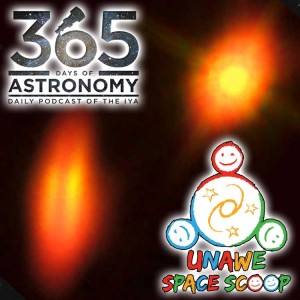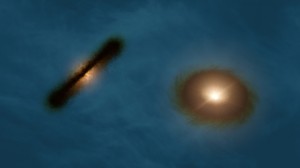Podcaster: Richard Drumm
 Title: Space Scoop: Slanted Solar Systems Surprise Scientists
Title: Space Scoop: Slanted Solar Systems Surprise Scientists
Organization: Astrosphere New Media
Link : astrosphere.org ; http://unawe.org/kids/unawe1430/
Description: Space scoop, news for children.
Bio: Richard Drumm is President of the Charlottesville Astronomical Society and President of 3D – Drumm Digital Design, a video production company with clients such as Kodak, Xerox and GlaxoSmithKline Pharmaceuticals. He was an observer with the UVa Parallax Program at McCormick Observatory in 1981 & 1982. He has found that his greatest passion in life is public outreach astronomy and he pursues it at every opportunity.
Today’s sponsor: This episode of “365 Days of Astronomy” is sponsored by — no one. We still need sponsors for many days in 2013, so please consider sponsoring a day or two. Just click on the “Donate” button on the lower left side of this webpage, or contact us at signup@365daysofastronomy.org.
Transcript:
This is 365 Days of Astronomy. Today we bring you a new episode in our Space Scoop series. This show is produced in collaboration with Universe Awareness, a program that strives to inspire every child with our wonderful cosmos.
Slanted Solar Systems Surprise Scientists
It’s well known that the planets, moons, asteroids and other objects in our Solar System orbit the Sun in a more-or-less perfectly flat rotating disc, like a spinning CD. But is this true for other Solar Systems in our Universe? By July 25th 2014, 1,811 planets had been found orbiting distant stars, and the majority of these planets do orbit their stars in roughly disc-shaped orbits.
But there are exceptions. Some planets have been found orbiting their parent stars along strange, tilted paths, not unlike our dwarf planet Pluto with it’s orbit tilted 17° to the ecliptic plane.
And we are now a step closer to understanding these weird and wonky systems. Unlike our solitary Sun, most stars form in binary pairs — two stars that are in orbit around each other.
Using the ALMA radio telescope in the Atacama Desert of Chile, astronomers have recently been observing two wildly crooked planet-forming gas discs around the young stars in a binary system called HK Tauri. They are in the constellation Taurus, just to the left or East of the Pleiades and almost due North of the brilliant red giant Aldebaran.
Two planet-forming discs (one around each star) are tilted almost at a right-angle to each other. The picture in today’s album artwork is a mixture of visible and infrared light from the Hubble space telescope and ALMA’s radio imagery to show us what the system is like.
These observations have provided us with the clearest picture ever of protoplanetary or planet-forming discs in a double star. So, why are these planet-forming discs so skewed? Because the two stars and their discs are not perfectly lined-up, the gravitational pull of one star pulls on the other’s disc, making it wobble. Any planets forming in one of these discs will also be disturbed by the other star’s gravity, causing its orbit to become tilted.
Here’s a Cool Fact: It looks like each star in the HK Tauri system will eventually have it’s own planet (or maybe multiple planets!) But in our galaxy there are some planets that orbit around two stars. These are called ‘circumbinary planets’ and there have been 17 discovered so far.
Thank you for listening to 365 Days of Astronomy!
365 Days of Astronomy is a community podcast made possible thanks to the contributions of people like you. Please consider donating at 365DaysofAstronomy.org/Donate
End of podcast:
365 Days of Astronomy
=====================
The 365 Days of Astronomy Podcast is produced by Astrosphere New Media. Audio post-production by Richard Drumm. Bandwidth donated by libsyn.com and wizzard media. You may reproduce and distribute this audio for non-commercial purposes. Please consider supporting the podcast with a few dollars (or Euros!). Visit us on the web at 365DaysOfAstronomy.org or email us at info@365DaysOfAstronomy.org. In the new year the 365 Days of Astronomy project will be something different than before….Until then…goodbye


